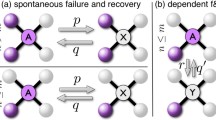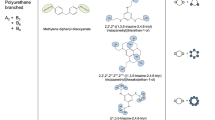Abstract
We consider a network the bonds of which are being sequentially removed; this is done at random but conditioned on the system remaining connected (self-repairing bond percolation, SRBP). This model is the simplest representative of a class of random systems for which the formation of isolated clusters is forbidden. It qualitatively describes the process of fabrication of artificial porous materials and degradation of strained polymers. We find a phase transition at a finite concentration of bonds p=p c , at which the backbone of the system vanishes; for all p< p c , the network is a dense fractal.
Similar content being viewed by others
References
D. Stauffer and A. Aharony, Introduction to Percolation Theory (Taylor and Fransis, London, 1994).
A. Bunde and S. Havlin, in Fractals and Disordered Systems, Ed. by A. Bunde and S. Havlin (Springer, Berlin, 1996).
Disorder and Granular Media, Ed. by D. Bideau and A. Hansen (North-Holland, Amsterdam, 1993).
Handbook of Material Weathering, Ed. by G. Wypych, 3rd ed. (William Andrew, Norwich, N.Y., 2003); The Effect of UV Light and Weather on Plastics and Elastomers (PDL Staff, Plastics Design Library, 1994).
S. S. Manna and B. Subramanian, Phys. Rev. Lett. 76, 3460 (1996).
R. Dobrin and P. M. Duxbury, Phys. Rev. Lett. 86, 5076 (2001).
H. N. V. Temperley and E. H. Lieb, Proc. R. Soc. London, Ser. A 322, 251 (1971).
R. M. Ziff, S. Finch, and V. Adamchik, Phys. Rev. Lett. 79, 3447 (1997).
F. Harary, Graph Theory (Addison-Wesley, Reading, Mass., 1969; Mir, Moscow, 1973).
P. Grassberger, Physica A (Amsterdam) 262, 251 (1999).
C. M. Newman and D. L. Stein, Phys. Rev. Lett. 72, 2286 (1994).
M. Cieplak, A. Maritan, and J. R. Banavar, Phys. Rev. Lett. 76, 3754 (1996).
Author information
Authors and Affiliations
Additional information
From Pis’ma v Zhurnal Éksperimental’no\(\overset{\lower0.5em\hbox{$\smash{\scriptscriptstyle\smile}$}}{l} \) i Teoretichesko\(\overset{\lower0.5em\hbox{$\smash{\scriptscriptstyle\smile}$}}{l} \) Fiziki, Vol. 79, No. 5, 2004, pp. 286–290.
Original English Text Copyright © 2004 by Ioselevich, Lyubshin.
This article was submitted by the authors in English.




